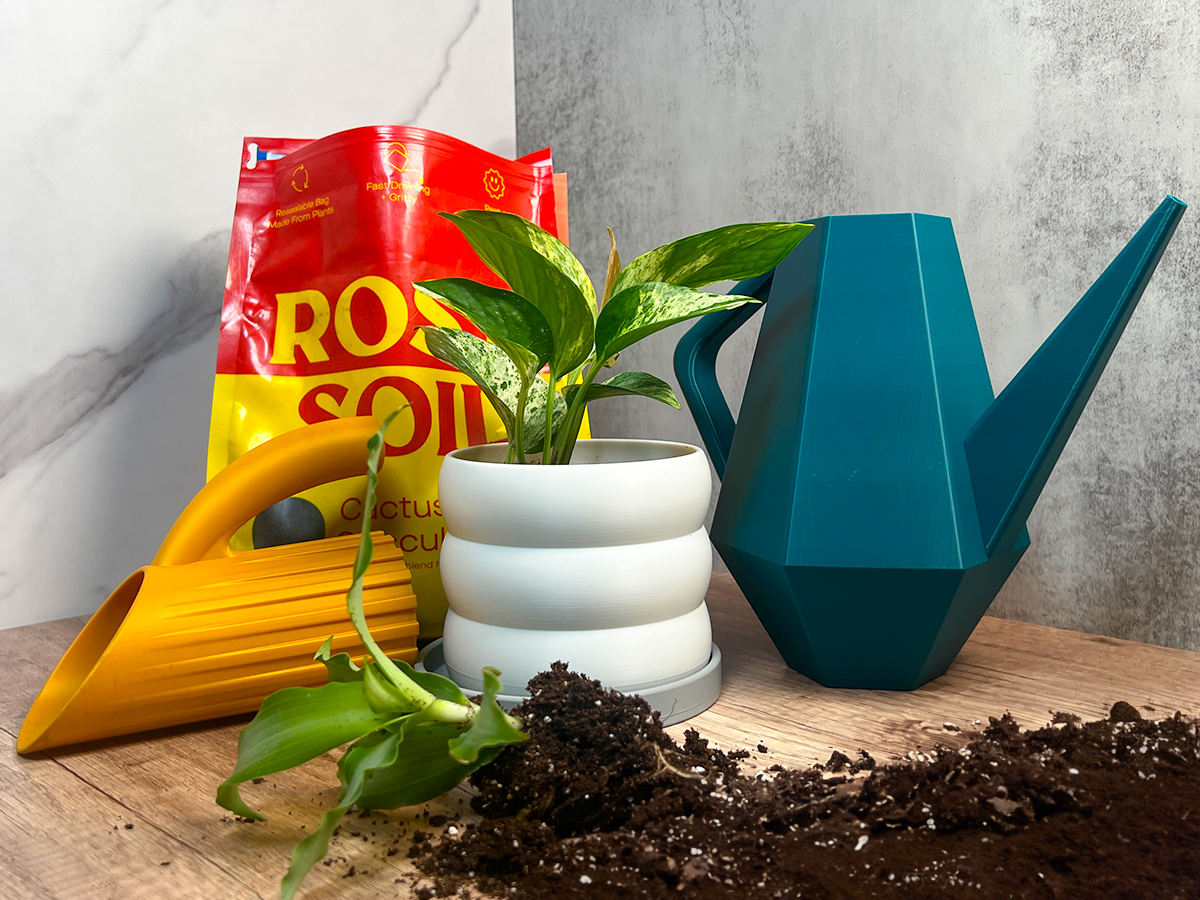
Step-by-Step Guide For Potting Up A New Houseplant
Steps To Follow For Potting Up A New Houseplant
The following steps would apply to most houseplants you buy and take home in person or receive through the mail.
Even though they may not have the same level of energy, bringing a new plant into your home might feel like bringing a new pet into your home. They brighten your day, improve the environment within your home (literally and in stark contrast to most pets), and require care and attention, though far less than any pet or other family members. The first step in assimilating a new houseplant into your space is potting it up. If you are unfamiliar with how it's done, this article will help you learn the simple steps needed to put up a new houseplant.
What's In This Post
1.) Choose The Right Houseplant
This may not seem relevant to "potting" the plant, but it is. If you are new to houseplants or have only worked with resilient species so far, like the Snake plant, ZZ plant, or Spider plant, i.e., a few plants that famously thrive on neglect, you should understand that many plants are very delicate and require proper care. Too much light (Ferns, Aglaonema), too little water (Calathea), not enough space (peace lily), and many other factors can practically kill such plants.
You also have to take the size and location (you can allocate to the plants in your house) into account. If the only place you have available in your home receives a consistent draft or only receives minimal daylight, you should pick houseplants that may survive these conditions (like Snake plants and Cast Iron plants). Similarly, some plants may require large planters to properly grow their root system, and if you are short on space, you should remain clear about these.
So before you can accept a new leafy member into your home, make sure it's "someone" you can care for and you have enough space, sunlight, and time.
2.) Choose A Good Planter
Choosing a good planter is much more than just about the space they occupy or the aesthetics. It’s also about the cost of different planters, shape, drainage, airflow they permit, etc. You might be most familiar with clay and ceramic pots and planters for indoor plants and synthetics for outdoor plants (as they are more resilient against the elements), but there are others as well.
A few basic factors to consider when choosing a planter are:
- Material: Clay, metal, plastic, ceramic, and wood are some of the materials planters are made from. Each has its own strengths and weaknesses. Some of these materials are more "breathable," which is crucial for certain plant types, while others may weather the elements better. Some innovative companies like Leafy Cove even use plant-based materials to create planters (using 3-D printing techniques), which significantly enhances the sustainability element of gardening. Not only is the material better than traditional alternatives, but the design can accommodate the plant's needs and help you provide optimal care to your leafy friends. From maximum drainage requirements like succulents to plants that need more air, optimally designed Leafy Cove planters are built to meet the care needs of every plant type.
- Drainage: Drainage is key when it comes to keeping houseplants healthy. Without proper drainage, you run the risk of overwatering or underwatering your plants. Conventional clay pots with a drain hole at the bottom are a popular choice, but you may have to make some manual adjustments (like adding a layer just above the drain hole) to ensure proper drainage over time. On the other end of the spectrum, 3-D printed pots with the right material may offer optimal drainage and airflow.
- Size: Choosing the size of the planter should depend upon the available space and the needs of the plant you have chosen.
- Aesthetics: While your plant won't mind the aesthetics at all (they are considerate this way), it will impact the overall image of your space, so make sure to choose colors, style, and material the blends in or at least compliment the space it's in and the plant.
3.) Buy The Right Soil
While your plant resides within the walls of the planter, it actually lives inside the soil (or soil and potting mix) within the planter. The wrong soil or potting mix will kill a houseplant much faster than a planter without adequate drainage, so there is less margin of error here. The good news is that over the millions of years since plants have been around, they have gotten used to the soil, so regular soil (packaged for houseplants) would be adequate for most houseplants. But exceptions exist, so if you are buying a unique or high-maintenance houseplant, make sure to buy the recommended soil or potting mix.
One amazing example would be Rosy Soil's all-organic soil, which is developed with minimal environmental impact and is highly sustainable. Its key elements and their benefits are:
Biochar: Horticultural charcoal that can retain oxygen, a wide range of nutrients, and microbes while being a carbon-rich source.
- Mycorrhizae: Microorganisms that live in the soil and allow plant roots to absorb more nutrients.
- Pine Bark Fines: Natural by-products of the mulch industry that provide soil structural strength and enhance its aeration properties.
- Compost: Sourced from bio-green waste and serves as a rich source of nutrients.
- Pumice: A volcanic rock that enhances soil’s drainage and aeration properties because of its porous composition.
Once the soil is safely in place, you may use boosters like Kelpy Fertilizers that promote overall plant health or Phosphorus-based fertilizers for root health.
4.) Recieve/Buy The Plant
Now that you have made the necessary arrangements, it's time to actually bring the actual plant home or receive it from the delivery service. Another way of getting a plant is by rescuing one. Rescue plants are distressed, undernourished, or neglected plants that you can nurture back to health and help thrive in your home.
In most cases, you will receive/get your plant in three different ways. How and when you pot them may be influenced by how you receive /get them.
- Bare-Root: Plants like roses or Perennials often arrive in bare-root form. These should be planted as soon as possible, but until you can, keep them in a cool and moist environment.
- Boxes: In many cases, you may receive your plants in a box, especially if they are relatively small. The root system is often in its own little plastic box serving as a temporary pot. With the plants you receive in boxes, a good rule of thumb is to give them one to three weeks to get used to the environment. You can keep them in their existing container, prune away any dead/weak leaves, and water the plant. The watering part is crucial because the existing container may not have proper drainage. You should moisten the soil around the plants instead of properly watering them, although for plants that need a lot of water, you may want to provide a little bit more water.
- Grow Bags: For grow bags, the protocol is the same as it is for plants that come in boxes - waiting and then potting. One main difference is that, unlike boxes, grow bags may be porous enough to drain the water in the soil even more effectively than a planter. So, one, you need to keep it somewhere you don't mind getting wet, and two, water it more frequently and thoroughly to ensure that your plants are getting the necessary amount of water.
5.) Clean Your Plant
When you are buying a healthy plant from a shop and taking it directly home, it's natural to assume that it's clean and ready for planting.
But if you rescue a plant or receive one in the mail, you can't be sure of the environment it lived/traveled in and the pathogens it was exposed to and carried with it to your home. The safest option is to always clean your plant before planting.
There are multiple approaches to plant cleaning, but one of the easiest is to add 1 tbsp of neem oil and 1 tbsp of castile soap (mint or unscented - no additional chemicals) or organic dish soap in a liter of lukewarm water. Then, gently spray the plant with this mixture and wipe the leaves out with a soft cloth.
6.) Prepare The Planter
Once the plants are ready, you need to prepare the planter to welcome its new inhabitants. If you are using a conventional planter where you have to add a layer to manage the drainage hole, that would be part of the preparation. That’s not something you need to do with planters designed for great drainage. Now, if the plant you have is large enough and has sizable roots, you don’t have to do anything. But if it’s small, you should add a small layer of soil (and potting mix).
7.) Inspect The Plant And Prepare The Root Ball For Planting
For a bare-root plant, all you have to do is ensure that the root is healthy. If needed, cut out the dried/weak part of the roots. But if you receive your plant in a grow bag or box, the root system will have a strong hold on the part of the existing soil it's in. It's important to note that, most likely, the plant has used up all the useful nutrients in the current soil/potting mix, and holding on to it may not be beneficial in any way. So gently (or roughly, if the roots are strong enough), shake away as much of the soil as possible. Even getting rid of as much as a third of the existing soil is good enough. This is also the part where you can inspect and cut away roots that are unhealthy.
You can also expand the roots using your fingers so they take up the entire diameter/width of your planter, but only if the roots seem strong enough for this type of manhandling. In some rootbound plants, the roots may be tightly circled in a compact space. Loosening them away from each other gives them more space for growth.
8.) Pot Up The Plant and Add Soil/Potting Mix
Once the plant is in place, you need to bury the roots in the soil. Make sure all the roots are covered, but there is no need to top up the planter. Too much soil can "suffocate" the roots and limit oxygen exchange from the surface, which may increase the chances of root rot. If you don't like your plant sitting too deep into the planter, removing it and padding up the base with more soil is a good idea.
And Voila! In eight easy steps, you have potted a new house plant. 🪴
Quick Tips:
- Travel stress can make a plant weak, so learn to notice the signs and give it the necessary care before potting it up.
- Water your plant right after potting, and then develop a schedule that works for you and your plant's needs.
- Keep a special eye on the plant in the few days right after the potting to ensure that it’s taking well to its soil and surroundings. If you spot any danger signs, repotting might be necessary.
Final Words:
Now that you have helped your new leafy roommate settle down, get ready for one of the least demanding relationships of your life. This roommate and friend requires just a little bit of attention, the right spot in your home (based on its light preferences), and occasional pruning. Like any other relationship, you will learn more about it and its preferences as you live together, but we can assure you that with just a little bit of care and effort, this will be one of the "healthiest" relationships of your life.

